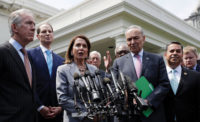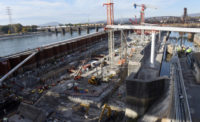After months of delay, President Trump has released a detailed outline of a long-promised infrastructure investment plan, which the administration says will result in at least $1.5 trillion for a variety of projects over the next 10 years and shorten federal project permitting to no more than two years, White House officials say.
The plan, released on Feb. 12, seeks congressional approval for $200 billion in direct federal funding. When combined with what the White House expects will be matching funds from state and local agencies, as well as the private sector, the result will be $1.5 trillion in total investment, a senior White House official says.
A Trump Administration official acknowledged that the plan is far from the last word on infrastructure funding.
The senior official told reporters in a Feb. 11 background briefing that the administration will be “quite flexible” in its stance toward ways of achieving its main infrastructure goals.
The proposal aims to assist a range of infrastructure types, such as highways, drinking-water and wastewater-treatment, river locks and dams, ports, energy and broadband. But it doesn't specify how much of the $200 billion or the desired nonfederal contributions, should go to each category. Instead, it appears to rely largely on state and local priorities.
The official acknowledged that the plan is far from the last word on infrastructure funding.
“This is the start of a negotiation,” the official said, “a bicameral, bipartisan negotiation, on how to find the best solutions for infrastructure in the U.S.”
Other White House officials note that at least six House committees and seven in the Senate will have jurisdiction over elements of the proposal. They are certain to want to put their own marks on any infrastructure legislation that may emerge in coming months.
"The ball is in Congress' court," says Steve Hall, American Council of Engineering Companies' vice president for government affairs. With the Trump proposal on the table, he adds, "Really, in a serious way now it will be the beginning of the process."
ASCE: 'Solid First Step'
Kristina Swallow, American Society of Civil Engineers' president, called the Trump plan "a solid first step in having a real conversation about solutions for the nation’s aging infrastructure and a path to address our infrastructure investment deficit."
But Swallow, as well as the American Association of State Highway and Transportation Officials and other infrastructure advocates. also want to see legislation that stems from the proposal to fix the Highway Trust Fund's revenue shortfall.
The White House official added, “We envision this will be a bipartisan push.” But he conceded that there is “disagreement” on Capitol Hill about the best way to achieve infrastructure investment goals.
The administration wants to offset the $200 billion by cuts in other programs, such as mass transit and the Dept. of Transportation’s popular Transportation Investment Generating Economic Recovery, or TIGER, grants, the official says, contending that administration officials feel those funds to date have not been spent “efficaciously.”
In his fiscal 2018 budget request early last year, Trump called for a sharp reduction in funds for new transit starts and eliminating TIGER, but Congress rejected those ideas.
Democrats: Too Skimpy
Democrats agree that U.S. infrastructure has large needs but quickly criticized the Trump proposal for being too skimpy on federal funding and for recommending offsetting cuts
Sen. Ron Wyden (Ore.), the Finance Committee's ranking Democrat, said in a statement that "$200 billion is a drop in the bucket compared with the $1.5 trillion Republicans in Congress just spent to slash taxes for multinational corporations and the donor class."
Sen. Bill Nelson (Fla.), the Commerce Committee's top Democrat, said, "We need to real investments—not cuts—in Florida and communities around the country."
House Democrats on Feb. 8 announced their own $1-trillion, 10-year infrastructure proposal, with all of that money to come from federal spending. House and Senate Democrats had rolled out a similar plan in early 2017.
ACEC's Hall says, "At the end of the day it's going to have to be bipartisan. Otherwise, a bill doesn't get out of the Senate, and to do that, you need money."
In their earlier comments on the infrastructure plan, Trump and other officials have emphasized the expedited permitting plan. The senior official said that the environmental reviews, up to signing of a National Environmental Policy Act “record of decision,” would take no more than 21 months and issuing a permit a maximum of three months beyond that.
Under the administration’s plan, it would designate one federal agency to be in charge of federal reviews for each project, with the selection depending on the type of project. He also said the White House will seek to give more permitting authority to the states.
The senior official said that besides the more than $1-trillion goal and faster environmental reviews, the plan’s other major objectives are investing in rural infrastructure and education and other steps to improve the workforce to carry out the envisioned projects.
The White House officials’ comments during the briefing didn’t include major new disclosures but tracked closely with administration comments since last spring.
Dividing Up the $200 Billion
Of the $200 billion, half would be “incentives” to draw state and local infrastructure funds. Another $20 billion would go to expand existing federal infrastructure loan programs, the largest of which is the Transportation Infrastructure Finance and Innovation Act program, or TIFIA.
In addition, $50 billion of the $200 billion would be block grants to governors for rural projects. Another $20 billion would be for “transformative programs,” the White House official says, for projects that represent a “next-century type of infrastructure, as opposed to just rebuilding what we have currently.”
The remaining $10 billion would be for a “capital financing fund.”
The senior official also said that “we’re going to keep existing [infrastructure] programs in place, for the most part,” specifically mentioning the Highway Trust Fund and federal aid to state revolving funds for drinking-water and wastewater-treatment projects.
Story updated on Feb.12 with link to detailed outline and with industry and congressional reactions.






Post a comment to this article
Report Abusive Comment